-
Notifications
You must be signed in to change notification settings - Fork 1
Issue 1
This issue is trying to obtain a code coverage of 80% on the helpafamily.margaritahumanitarian.org project code. The Margarita Humanitarian Foundation is a 501c3 nonprofit public charity located in Palmdale, California (USA) that provides free assistance for people in need. They offer many services such as youth mentorship, health, career, and education workshops and training so the less fortunate can get access to social services, healthcare, food, and more aid in the golden state. Its mission is to develop high-impact ways to help underserved and marginalized groups. Their portfolio contains some programs in the Antelope Valley region and globally. They help families who need help the most, addressing the whole family's needs, from youths to elders, always with kindness and love. It is possible to learn more about the project on the website.
There are undeniable advantages to testing software products; therefore, the authors will not enumerate them here. At the time of the fork, the project only contained a few set tests. The main goal of the issue is to get to 80% code coverage, so we developed one main task plan and a test plan - in this section, we will primarily focus on the task plan since the authors of this report will address the test plan later on. We will start by implementing end-to-end tests with Selenium IDE and Jest. This setup allows us to test the main features of the web application - so we can maximize the test coverage with the time constraints that we have. In the second stage of the testing project, we intend to start to test the main modules of the project in order of criticality - also to prevent an invisible path problem situation. We aim to help the Margarita Humanitarian Foundation provide its user base with a web application that guarantees no failure with this approach, so they can continue to help their community.
Since the primary goal of this issue was to achieve 80% of code coverage, this section will point out some system requirements for which tests were designed.
The principal purpose of this project is to help families in need to help, so to do that...
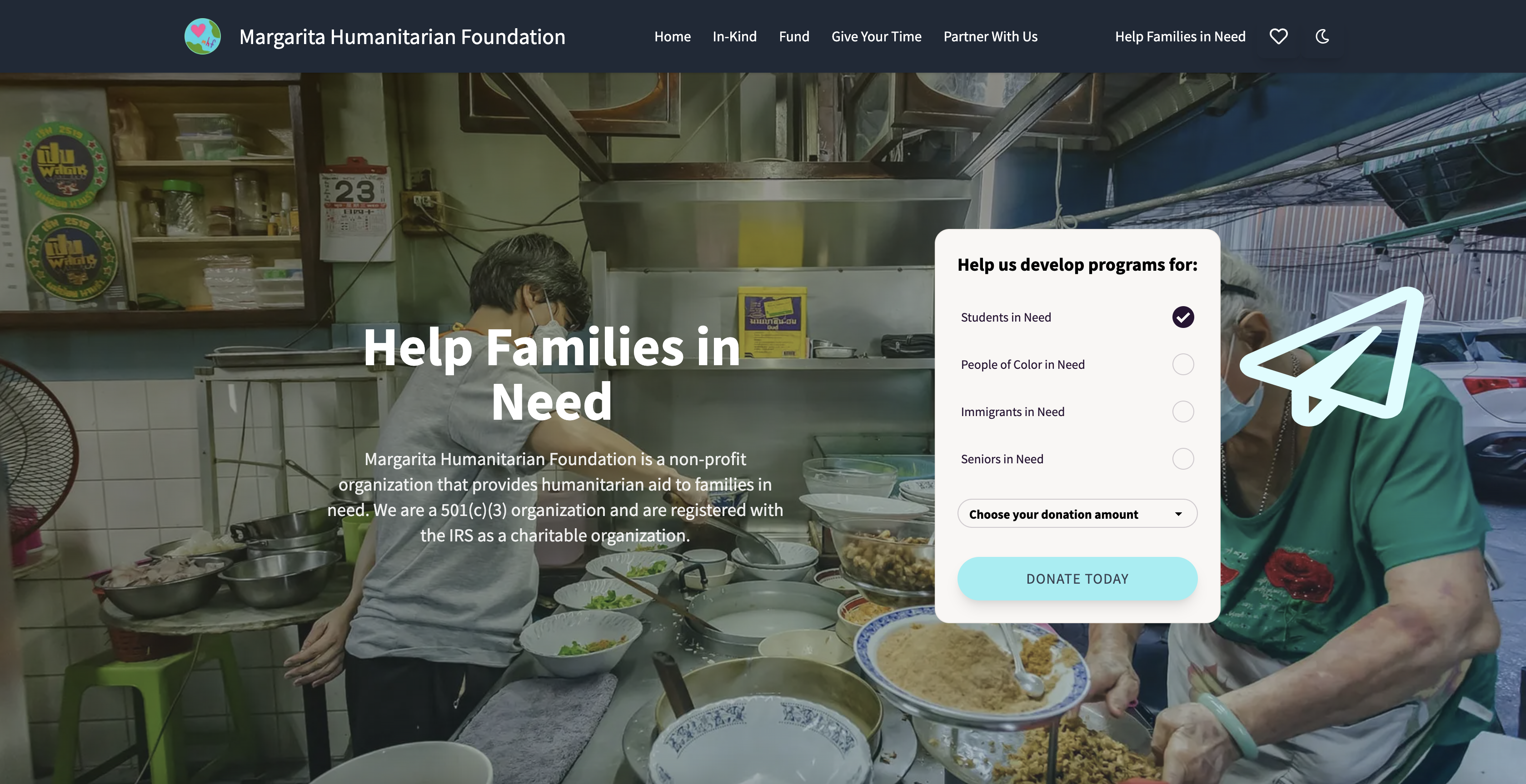
-
To test this requirement, we made three tests:
-
Try to donate without selecting a cause.
-
Try to donate without selecting an amount.
-
Try to donate with a cause and an amount.
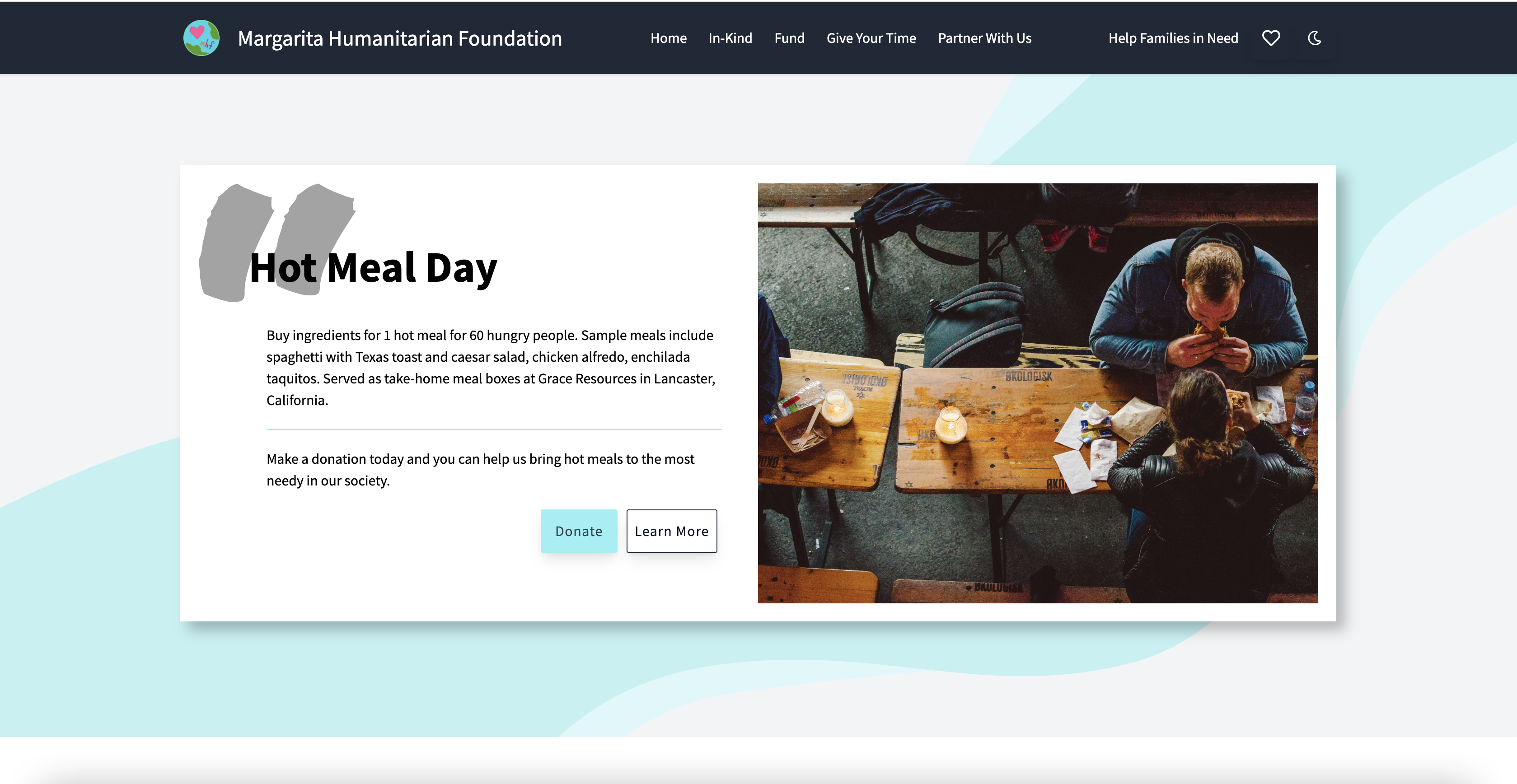
-
To test this requirement, we made two tests:
-
Click on Learn more button.
-
Click on donate button and make a donation.
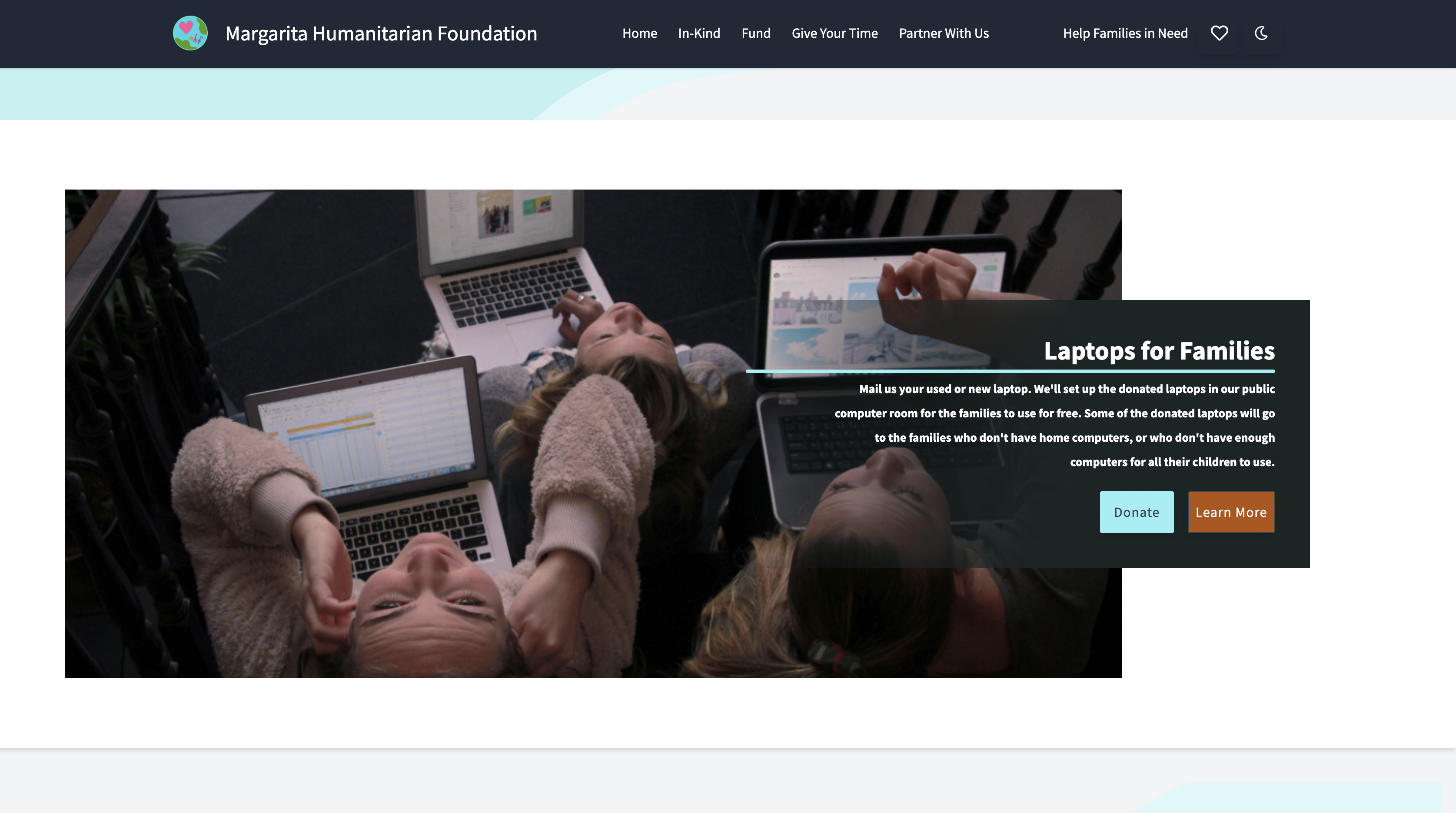
-
To test this requirement, we made two tests:
-
Click on Learn more button.
-
Click on donate button and make a donation.
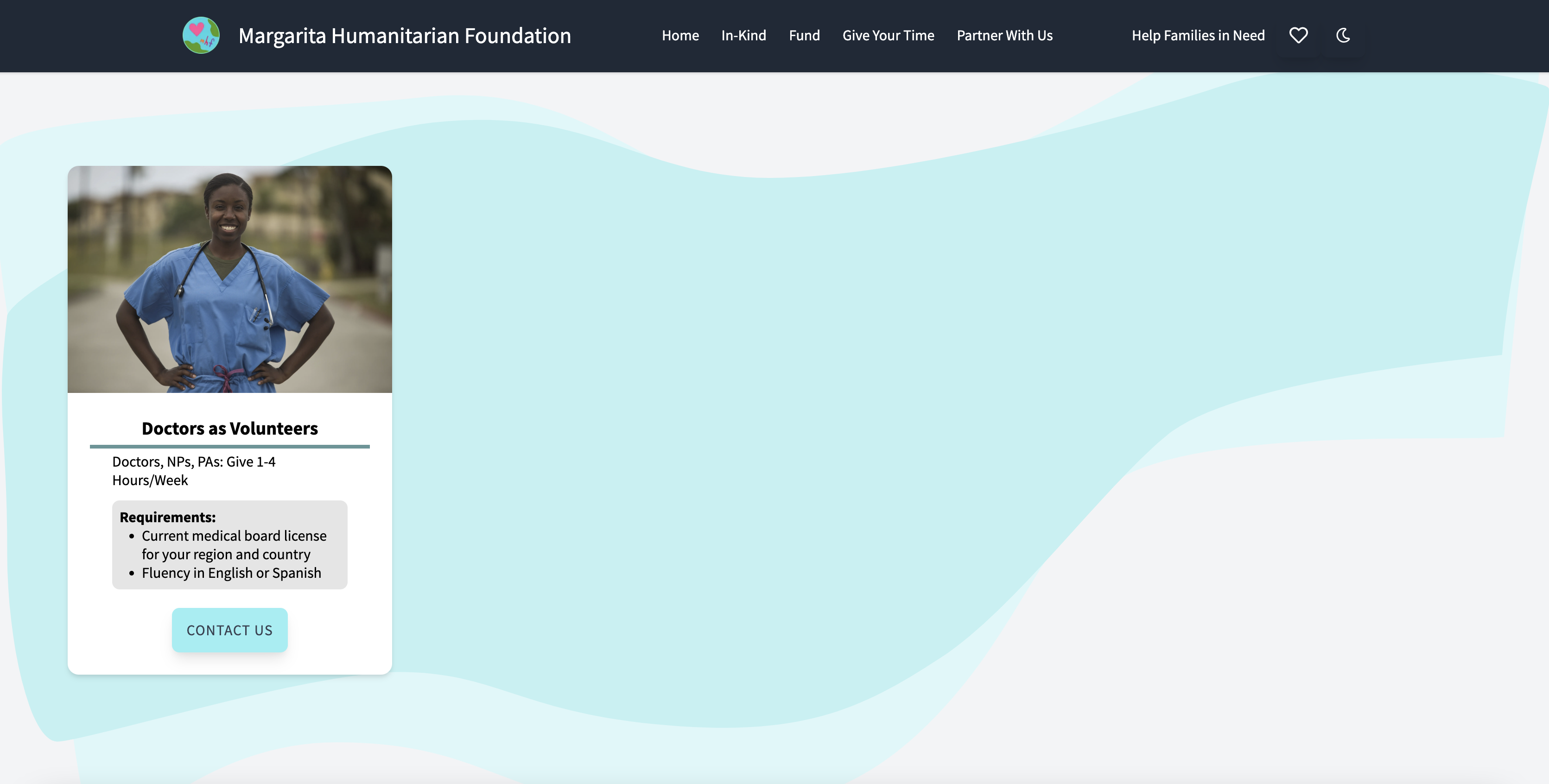
-
To test this requirement, we made one test:
-
Click on the contact button and send an email.
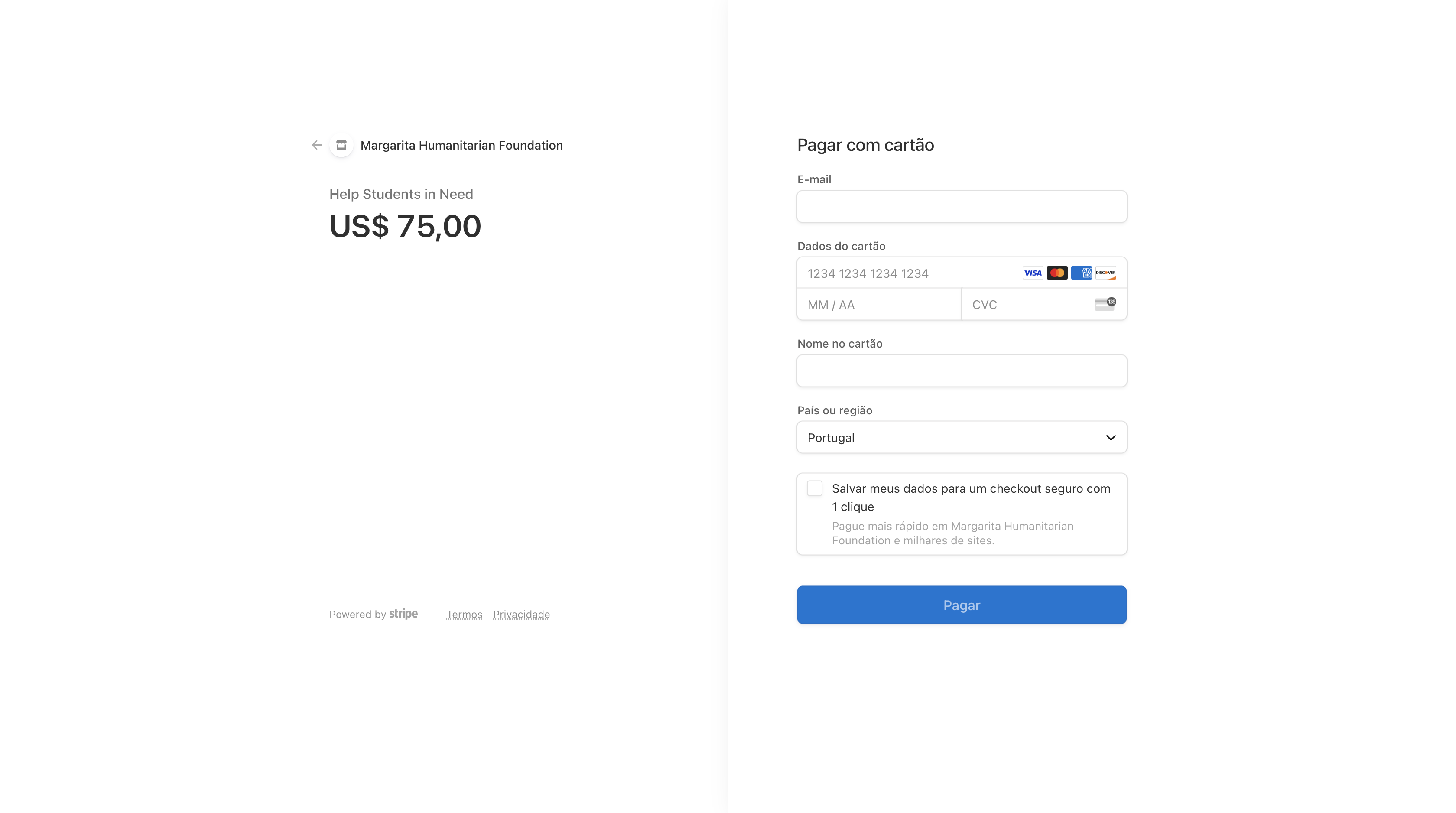
-
To test this requirement, we made many tests:
-
Try to enter invalid data.
-
Try to enter data.
-
Click on the "Pay" button without writing the input data needed.
One of the best forms of test documentation there is the test plan. We used a variation of the IBM test plan model. According to the IBM documentation, the test plan describes the scope of the overall test effort and provides a record of the test planning process. Typically, a test plan identifies requirements, risks, test cases, the test environments, business and quality objectives, test schedules, and other items. However, the test plan had to have some adaptations to enable the application of restrictions imposed by the nature of the language and project.
The test plan consists of six columns - Scenario, Steps, Tester Name, Approval Criteria, Actual result, and Final result. The Scenario, Tester Name, Approval Criteria, Actual, and Final results attributes are self-explanatory, but the feature " Steps" comes from BDD. The Steps attributes must contain a sequence of steps that allows us to conduct a test on the webpage. For example, "Open the browser," "click on ...," "Fill in the payment form," and other actions that combined make an acceptance test.
Another essential detail is that these tests were tailored-made for a computer (MacOs) with the web browser Chrome. It is possible to conduct these tests on Firefox, Safari, Opera, and other significant browsers, OSs, and devices. However, we did not perform them due to time and infrastructure limitations. We needed to use a Selenium Grid and create some system configurations, for example, a Linux PC with Firefox, a Windows PC with Microsoft Edge, and an iPhone with Chrome. Some of these environments need paid licenses. Configuring and allocating this network would cost valuable time and (maybe) monetary resources, defeating the purpose of the curriculum unit. In the future, if the charity association picks up and requires more "heavy-weight" tests to ensure a higher level of code quality, it is possible to assemble such infrastructure at some expense - time and resources manly. It is possible to find the test plan on the following link.
The main source code files to fix these issues are the following:

Note: Some dependencies needed to be added; that is why the package.json and yarn. We also altered lock files.
We developed the test scripts with the help of Selenium IDE. The IDE allows us to perform capture and replay tests and then export the tests into JavaScript. However, the process is not as straightforward as it might first appear. After exporting the scripts, we needed to adjust the functions that find the web page elements. It is a common issue with Selenium. Selenium sometimes does not see the web page elements, especially if they are inside a combo box. Therefore, we need to search each part of the web page manually and find its exact location so that Selenium can see it. Another issue that we had during the development of the test scripts is that these tests run at CPU speeds. So they do not encompass the time that it takes for a web page to load or the time that a user takes when clicking on some element. Therefore, we adjusted the speed at which the tests run so they could wait for pages to load or for monetary transactions to take place. One final note that it is essential to mention is that the project had a pretty file built-in that obligated developers to follow a standard code. This configuration helps ensure the standardization of the contributions and provides quality standards across the project. Another aspect to consider when writing these tests is the configuration of the test environment — one of the reasons we had some initial problems when implementing the issue. We needed to align the Chrome version of our machines to the Chrome (web-driver) of the Selenium IDE; otherwise, it would not run. The readers can observe a test file below:
// Porto, 2022
// This code was made with love by Francisco Bastos (https://www.linkedin.com/in/francisco-bastos-031369160/)
// for the curriculum unit of Comprehension and Evolution of Software at the
// master's in Software Engineering at the Faculty of Engineering of the University of Porto.
// Feel free to contact the author if any questions arise.
//
import { Builder, By, until } from 'selenium-webdriver';
import assert from 'assert';
describe('Make a donation', function () {
jest.setTimeout(60000);
let driver;
// eslint-disable-next-line no-unused-vars
let vars;
beforeEach(async function () {
driver = await new Builder().forBrowser('chrome').build();
vars = {};
});
afterEach(async function () {
await driver.quit();
});
it('Make a donation', async function () {
// Test name: Make a donation
// Step # | name | target | value
// 1 | open | / |
await driver.get('http://localhost:3000/');
// 2 | setWindowSize | 1920x1080 |
await driver.manage().window().setRect({ width: 1920, height: 1080 });
// 3 | click | xpath=//input |
await driver.findElement(By.xpath('//input')).click();
// 4 | click | xpath=//label[contains(.,'People of Color in Need')] |
await driver
.findElement(By.xpath("//label[contains(.,'People of Color in Need')]"))
.click();
// 5 | click | xpath=//label[contains(.,'Immigrants in Need')] |
await driver
.findElement(By.xpath("//label[contains(.,'Immigrants in Need')]"))
.click();
// 6 | click | xpath=//label[contains(.,'Seniors in Need')] |
await driver
.findElement(By.xpath("//label[contains(.,'Seniors in Need')]"))
.click();
// Apply timeout for 10 seconds
await driver.manage().setTimeouts({ implicit: 10000 });
// 7 | click | xpath=//select |
await driver.findElement(By.xpath('//select')).click();
// 8 | select | css=#amount and xpath=//option[. = '$5'] | label=$5
{
const dropdown = await driver.findElement(By.css('#amount'));
await dropdown.findElement(By.xpath("//option[. = '$5']")).click();
}
// 9 | click | xpath=//form/div/button[2] |
await driver.findElement(By.xpath('//form/div/button[2]')).click();
// 10 | click | xpath=//input[@id='email'] |
await driver.findElement(By.xpath("//input[@id='email']")).click();
// 11 | type | xpath=//input[@id='email'] | [email protected]
await driver
.findElement(By.xpath("//input[@id='email']"))
.sendKeys('[email protected]');
// 12 | click | xpath=//div[@id='cardNumber-fieldset']/div/div/div/span/input |
await driver
.findElement(
By.xpath("//div[@id='cardNumber-fieldset']/div/div/div/span/input")
)
.click();
// 13 | type | xpath=//fieldset/div/div/div/div/span/input | 6011 1111 1111 1117
await driver
.findElement(By.xpath('//fieldset/div/div/div/div/span/input'))
.sendKeys('6011 1111 1111 1117');
// 14 | type | xpath=//div[@id='cardNumber-fieldset']/div[2]/div/div/span/input | 11 / 26
await driver
.findElement(
By.xpath("//div[@id='cardNumber-fieldset']/div[2]/div/div/span/input")
)
.sendKeys('11 / 26');
// 15 | type | xpath=//div[@id='cardNumber-fieldset']/div[3]/div/div/span/input | 123
await driver
.findElement(
By.xpath("//div[@id='cardNumber-fieldset']/div[3]/div/div/span/input")
)
.sendKeys('123');
// 16 | type | xpath=//div[3]/div/div/div/div/div[2]/div/div/div/div/span/input | Francisco
await driver
.findElement(
By.xpath('//div[3]/div/div/div/div/div[2]/div/div/div/div/span/input')
)
.sendKeys('Francisco');
// 17 | click | xpath=//div[3]/div/div/span/input |
await driver.findElement(By.xpath('//div[3]/div/div/span/input')).click();
// 18 | click | xpath=//div[@id='root']/div/div/div[2]/div/div[2]/form/div[2]/div[2]/button/div[3] |
await driver
.findElement(
By.xpath(
"//div[@id='root']/div/div/div[2]/div/div[2]/form/div[2]/div[2]/button/div[3]"
)
)
.click();
// 19 | waitForElementPresent | xpath=//h1[contains(.,'Thank You!')] | 60000
await driver.wait(
until.elementLocated(By.xpath("//h1[contains(.,'Thank You!')]")),
60000
);
// 20 | assertText | //*[@id="__next"]/html/body/div/div[1]/div/div/h1 | Thank You!
assert(
(await driver
.findElement(
By.xpath('//*[@id="__next"]/html/body/div/div[1]/div/div/h1')
)
.getText()) == 'Thank You!'
);
});
});This test file portrays the test "Make a donation," and it is pretty simple to read (one of the advantages of Selenium IDE). In the following section, we create the test environment. We extend the test timeout to roughly 16.(6)h, so the test has time to execute. Then we initialize and create the Chrome Driver and set the behavior for after the test - quit and close the browser:
jest.setTimeout(60000);
let driver;
// eslint-disable-next-line no-unused-vars
let vars;
beforeEach(async function () {
driver = await new Builder().forBrowser('chrome').build();
vars = {};
});
afterEach(async function () {
await driver.quit();
});Now we access the web page and then start the search for each element of the web page filling in every form and simulating a typical user flow.
it('Make a donation', async function () {
// Test name: Make a donation
// Step # | name | target | value
// 1 | open | / |
await driver.get('http://localhost:3000/');
// 2 | setWindowSize | 1920x1080 |
await driver.manage().window().setRect({ width: 1920, height: 1080 });
// 3 | click | xpath=//input |
await driver.findElement(By.xpath('//input')).click();
// 4 | click | xpath=//label[contains(.,'People of Color in Need')] |
await driver
.findElement(By.xpath("//label[contains(.,'People of Color in Need')]"))
.click();
// 5 | click | xpath=//label[contains(.,'Immigrants in Need')] |
await driver
.findElement(By.xpath("//label[contains(.,'Immigrants in Need')]"))
.click();
// 6 | click | xpath=//label[contains(.,'Seniors in Need')] |
await driver
.findElement(By.xpath("//label[contains(.,'Seniors in Need')]"))
.click();
// Apply timeout for 10 seconds
await driver.manage().setTimeouts({ implicit: 10000 });
// 7 | click | xpath=//select |
await driver.findElement(By.xpath('//select')).click();
// 8 | select | css=#amount and xpath=//option[. = '$5'] | label=$5
{
const dropdown = await driver.findElement(By.css('#amount'));
await dropdown.findElement(By.xpath("//option[. = '$5']")).click();
}
// 9 | click | xpath=//form/div/button[2] |
await driver.findElement(By.xpath('//form/div/button[2]')).click();
// 10 | click | xpath=//input[@id='email'] |
await driver.findElement(By.xpath("//input[@id='email']")).click();
// 11 | type | xpath=//input[@id='email'] | [email protected]
await driver
.findElement(By.xpath("//input[@id='email']"))
.sendKeys('[email protected]');
// 12 | click | xpath=//div[@id='cardNumber-fieldset']/div/div/div/span/input |
await driver
.findElement(
By.xpath("//div[@id='cardNumber-fieldset']/div/div/div/span/input")
)
.click();
// 13 | type | xpath=//fieldset/div/div/div/div/span/input | 6011 1111 1111 1117
await driver
.findElement(By.xpath('//fieldset/div/div/div/div/span/input'))
.sendKeys('6011 1111 1111 1117');
// 14 | type | xpath=//div[@id='cardNumber-fieldset']/div[2]/div/div/span/input | 11 / 26
await driver
.findElement(
By.xpath("//div[@id='cardNumber-fieldset']/div[2]/div/div/span/input")
)
.sendKeys('11 / 26');
// 15 | type | xpath=//div[@id='cardNumber-fieldset']/div[3]/div/div/span/input | 123
await driver
.findElement(
By.xpath("//div[@id='cardNumber-fieldset']/div[3]/div/div/span/input")
)
.sendKeys('123');
// 16 | type | xpath=//div[3]/div/div/div/div/div[2]/div/div/div/div/span/input | Francisco
await driver
.findElement(
By.xpath('//div[3]/div/div/div/div/div[2]/div/div/div/div/span/input')
)
.sendKeys('Francisco');
// 17 | click | xpath=//div[3]/div/div/span/input |
await driver.findElement(By.xpath('//div[3]/div/div/span/input')).click();
// 18 | click | xpath=//div[@id='root']/div/div/div[2]/div/div[2]/form/div[2]/div[2]/button/div[3] |
await driver
.findElement(
By.xpath(
"//div[@id='root']/div/div/div[2]/div/div[2]/form/div[2]/div[2]/button/div[3]"
)
)
.click();The following instructions show that we need to extend the time for the test to run, even for specific actions. We rose the timeout again for 60000 seconds.
// 19 | waitForElementPresent | xpath=//h1[contains(.,'Thank You!')] | 60000
await driver.wait(
until.elementLocated(By.xpath("//h1[contains(.,'Thank You!')]")),
60000
);Now we test the web page and try to assert the web page's content with the message "Thank You!" which means that a donation was correctly made.
// 20 | assertText | //*[@id="__next"]/html/body/div/div[1]/div/div/h1 | Thank You!
assert(
(await driver
.findElement(By.xpath('//*[@id="__next"]/html/body/div/div[1]/div/div/h1'))
.getText()) == 'Thank You!'
);The remaining tests follow a structure very similar to this one.